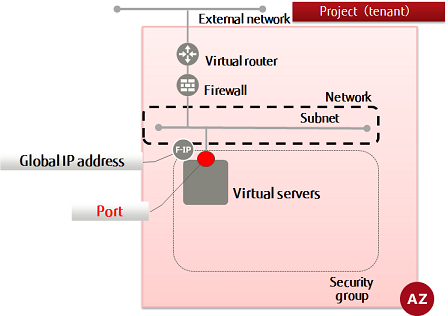This section explains how to create a port (network interface) to be associated with an IP address, for connecting resources such as virtual servers to a network.
If only the subnet is specified when creating the resources below, the system will automatically create a port and assign an IP address to it.
- Virtual server
Note: To manually specify an IP address instead of having one automatically assigned using DHCP when deploying a virtual server, create a port associated with that IP address in advance, and then assign it to the virtual server.
Tip: You can add multiple ports to a virtual server.
- Virtual router
Note: A port is assigned automatically only when created for a default gateway (x.x.x.1). When adding a virtual router to a network that already has a virtual router connected with the x.x.x.1 address, it is necessary to configure the port manually.
-
Set the environment variables below as follows:
$ PORT_NAME=<portName>(any)
$ NETWORK_ID=<networkId>
$ SUBNET_ID=<subnetId>
$ FIXED_IP_ADDRESS=<ipAddrToBeSpecified> (specify using format "XXX.XXX.XXX.XXX" within a range specified during creation of subnet)
$ SG_ID=<securityGroupId>
-
Execute the following API:
$ curl -Ss $NETWORK/v2.0/ports -X POST \
-H "X-Auth-Token: $OS_AUTH_TOKEN" -H "Content-Type: application/json" \
-d '{"port": {"network_id": "'$NETWORK_ID'", "name": "'$PORT_NAME'",
"availability_zone": "'$AZ'", "fixed_ips":
[{"subnet_id": "'$SUBNET_ID'", "ip_address': "'$FIXED_IP_ADDRESS'"}],
"security_groups": ["'$SG_ID'"]}}' | jq .
The following response is output:
{
"port": {
"status": "<status>",
"name": "<portName>",
"allowed_address_pairs": [],
"admin_state_up": true,
"network_id": "<networkId>",
"tenant_id": "<projId>",
"binding:vnic_type": "normal",
"device_owner": "",
"mac_address": "<macAddr>",
"fixed_ips": [
{
"subnet_id": "<subnetId>",
"ip_address": "<ipAddrToBeSpecified>"XXX.XXX.XXX.XXX""
}
],
"id": "<portId>",
"security_groups": [
null
],
"device_id": "",
"availability_zone": "<availabilityZone>"
}
}
For the availability zones, AZ1 is expressed as "jp-east-1a", and AZ2 is expressed as "jp-east-1b".
-
Execute the following API to check the port that you created:
$ curl -Ss $NETWORK/v2.0/ports -X GET \
-H "X-Auth-Token: $OS_AUTH_TOKEN" \
| jq '.ports[]| .name, .status, .id, .fixed_ips[]'
If a list including the port name that you specified is output, as follows, that means the port was created successfully.
...
""
"<status>"
"<portId>"
{
"subnet_id": "<subnetId>",
"ip_address": "<privateIpAddr>>"
}
...
